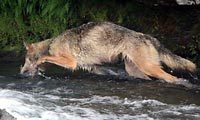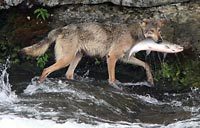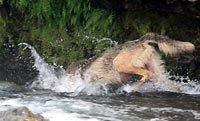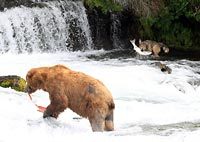Photographer gets the catch of the day

ANCHORAGE — When a lone, female wolf appeared at the Brooks River Falls in Katmai National Park & Preserve this summer and began catching sockeye salmon as if she were the most efficient of brown bears, photographer Paul Stinsa didn't know what to think.
So he did what photographers do. He took pictures.
Wolves long have been known to feed on salmon, but the way this wolf slipped into a fishing area owned by bears and the skill with which she went after the salmon caught some people by surprise.
"If I had a net and dynamite, I couldn't have caught fish so efficiently," said Stinsa, a Chicago-based manager for United Airlines. "She wasn't in the river two minutes, and she grabbed a fish and was out of there. She did this 15 times in a row."
When Stinsa's photographs first popped up on the Internet, they stopped Katmai superintendent Ralph Moore cold.
"What a neat thing," he said. "I wish I would have seen that, too."
A wolf vying for salmon along with the oft-photographed Brooks bears was startling enough that more than a few photographers thought the pictures might be computer-enhanced composites. Stinsa heard such comments, too.
"The photos are not doctored in any way," he said last week.
They were cropped, he said, and some spots with bad light were highlighted. Other than that, they are 100 percent as they appeared in the viewfinder of his camera, he said.
And he has Park Service employee Niki Quester as a witness.
"She said she'd never seen anything like this," Stinsa said.
Efforts to reach Quester were unsuccessful; there are no telephones at Brooks. Bosses and co-workers, however, confirmed she was present during several of the wolf's appearances.
David Person, an Alaska Department of Fish and Game biologist who studies wolves in southeast Alaska, said it is not unusual for the animals to catch salmon, but it is odd for them to use an area thick with bears.
"It would certainly seem to me highly unusual," he said.
Wolves and bears tend to be antagonistic toward each other, mainly because wolves have been documented killing bear cubs. Still, Person added, he has seen well-fed wolves ignore well-fed black bears and vice versa on salmon streams.
If there is enough food available, he said, the animals "might not really notice each other."
Conditions at Brooks Falls might also have played a role. Water levels in early July were unusually low, prompting many bears to move below the falls to feed.
So many bears had gathered that Stinsa said it was difficult reaching the viewing platform at the falls. A bridge connecting the cabins and campground to the platform was closed most of the day due to bear traffic.
When he arrived at the falls, Stinsa said, Quester was there along with a handful of Japanese tourists. They were on the platform.
Because there was so little traffic on July 8, however, Stinsa had extended time on the platform.
"The bridge was closed all afternoon," he said. "No one else seemed to get across."
The wolf appeared in the afternoon.
"The wolf kind of came out from under the platform," looked around and disappeared for about half an hour before reappearing on the far bank, Stinsa said.
Everyone on the platform thought the wolf was going to make a try for a pile of partially eaten salmon carcasses that had accumulated below the falls, he said.
But when a male bear chased a subadult out of the falls and opened up space, the wolf started fishing instead.
"She came down the [game] trail along the rock wall," Stinsa said.
Clearly, he said, she was watching the water and stalking salmon in the shallows. When she saw what she wanted, she lunged, grabbed a fish with her mouth and took off.
She returned within minutes. That was the pattern for slightly more than an hour. Bears often could be seen moving in the woods behind the wolf as she went to and from the river, Stinsa said. But she continued to fish.
He suspects she was either delivering fish to pups or handing them off to another wolf to carry to a den.
"I can't imagine what else she was doing," he said.
The wolf was seen fishing at Brooks Falls for several weeks and appeared to be nursing, Katmai ranger Peter Hamel said.
Person said the animal may have been merely eating fat-rich brains and eggs the way bears do when salmon are plentiful, and then returning for seconds. But he doesn't discount the possibility she was delivering fish to pups or to another wolf helping to feed pups.
Pup survival in southeast Alaska, he said, has been found to be unusually high because of this behavior. Some studies have concluded that up to one-quarter of the wolves' diet on Prince of Wales Island comes from marine sources, most likely salmon, and can be key to helping young wolves survive the difficult first year.
"I've watched them [catching salmon]," Person said. "I have no doubts about how efficient they are. They're actually very good at fishing."


